Rectangular Leonardo spaceframe
This page is about how to build a rectangular spaceframe
using angle iron - or similar material.
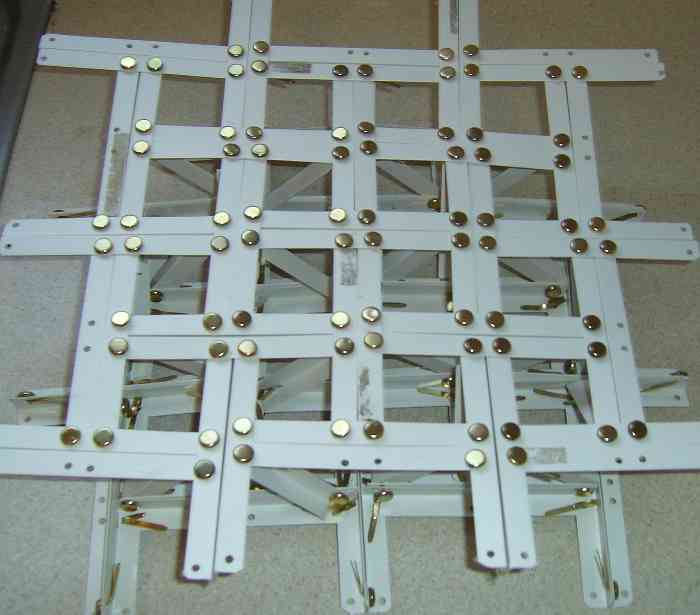
PVC angle model (plan)
|
The main attraction of using angle iron is that it is
inexpensive. It is one of the cheapest ways to buy steel
struts. It is the same material that is used to construct
electricity pylons.
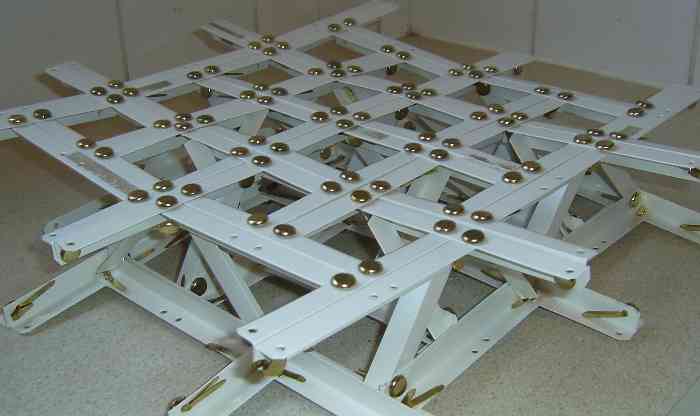
PVC angle model (front)
|
This page illustrates the layout using a model made of 12mm
PVC angle - and brass paper fasteners.
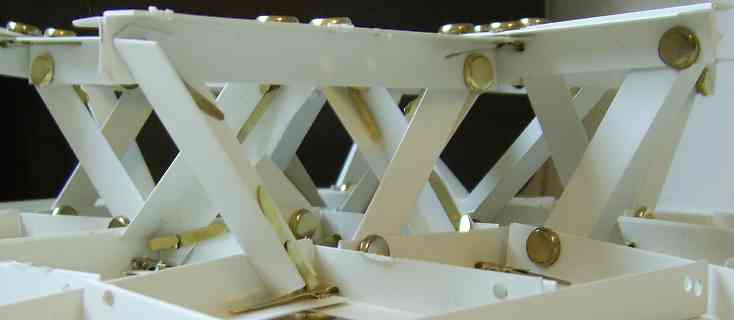
PVC angle model (under construction)
|
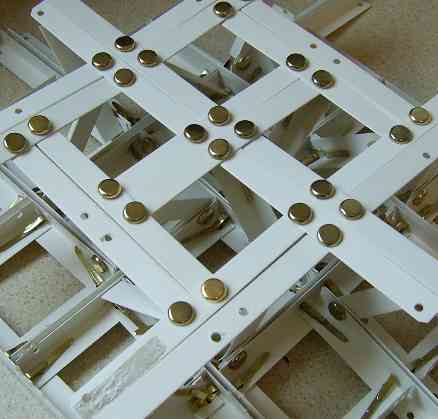
PVC angle model (isometric)
|
The spaceframe described here is based on a pattern by
Leonardo da Vinci.
It consists of two layers of "Leonardo" fabric, joined
together by connecting struts.
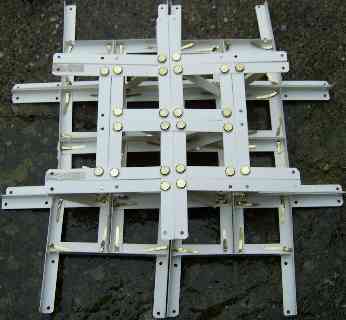
PVC angle (two layers)
|
|
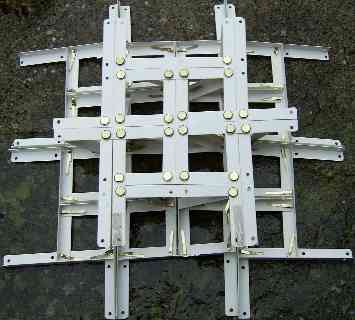
PVC angle (two layers)
|
The model illustrated lacks diagonal support running from
the top left to the bottom right.
In theory the structure is vulnerable to sheering forces
that exploit this omission.
Stabilising elements could be added in to resist such
forces.
However, in many applications the framework seems likely to
be supported around its edges - so in practice, the omission
of these elements is unlikely to me much of a cause for
concern.
The spaceframe described here has two identical layers,
which are joined together.
One such layer is illustrated in the following two pictures.
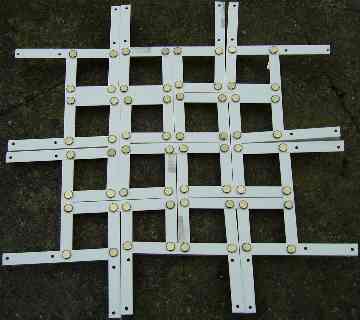
PVC angle (one layer, top)
|
|
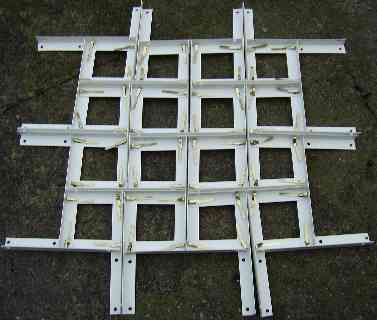
PVC angle (one layer, bottom)
|
The following diagram shows the relationship between the classical pattern
- as used by Leonardo da Vinci - and the one employed on this page.
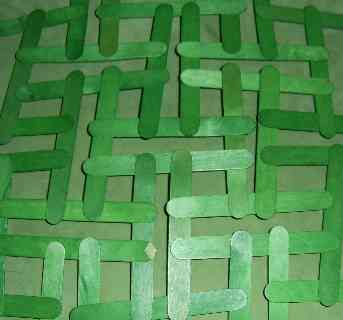
Classical 2D rectangular pattern
|
|
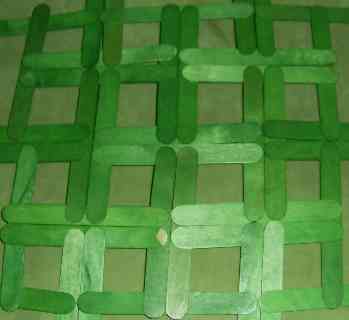
The pattern with struts pushed together
|
Inspiration
The design is based around a few basic ideas:
- The classical Leonardo roof design can be constructed
out of angle iron;
- Such a construction is naturally almost flat.
Given materials with appropriate dimensions, it could be
made to lie completely flat;
- Two such fabrics placed back to back can be easily
connected together with more angle iron to create a
rigid, prestressed structural framework;
- The resulting structure plays nicely with simple angle
iron boxes - which themselves are highly suitable as modular
construction units.
Application
This pattern could be used in a number of ways.
It could be used to construct ceilings, floors
or trussed roofing planes.
Alternatively, it could find application in the construction
of entire rooms.
An attraction in the latter case is that the single-layer
Leonardo fabric is excels at spanning large regions - without
any other support.
That means that supporting struts between the layers can
often be cheerfully omitted. That fact makes it easier to
create rooms that span multiple cells - and to create space
for doors and other openings.
Strength
As with other spaceframes, the structure is suprisingly
strong.
Despite being make of plastic only 0.7 millimetres thick,
the structure easily supports my own weight when I stand on
it:

PVC angle model under pressure
|
Configurations
Each layer has a chequerboard-like characteristic, with
alternate squares being identical.
In the configuration illustrated squares lie over squares of
the opposite type. The advantage of that is that it permits
all horizontal struts to be identically drilled.
The configuration obtained by placing squares over identical
squares has some advantages in the context of making a
framework with cells the size of rooms. In particular in
such a framework, the cells may more easily be varied in
size. Making the cells of different sizes can be useful -
when some cells are destined to be corridors.
Shaped surfaces
Deliberately-sheared versions of this fabric may be used to
construct anticlastic curved surfaces - for use in the
construction of saddle-shaped rooves.
Domes are also possible in theory - using the "Leonardo"
ability of the fabric. The shape would be limited to the
shape generated by the equivalent "Leonardo" dome under
those circumstance.
Vertical support
The pattern is quite suitable for stacking. If stacked very
high, adding additional vertical support to the lower cells
may become advisable - due to the extra weight they have to
bear. There's quite a lot of scope for adding additional
vertical struts in the cells to improve weight bearing
characteristics.
If used in very tall buildings, adding vertical
girders is likely to prove necessary - to supplement the
weight bearing properties of of the structure.
Limitations
The pattern depends on the ability to flex each struct
through the thickness of its metal twice over its length.
Struts that are too short to do that are not suitable for
performing this construction with.
If you have stiff short struts there are alternatives.
Rather than using a leonardo-style fabric, consider
one of the following alternatives:

Aluminium angle (dense)
|
This dense pattern is a close match to the Leonardo layout described above.
The struts are cut shorter - and there is no need to bend the
struts.

Aluminium angle (sparse)
|
This pattern is much sparser than the other ones illustrated.
Advantages
Compared to the more traditional layouts illustrated in
aluminium, the Leonardo pattern uses fewer connectors -
through using longer struts.
The longer struts provide strength - and use of the Leonardo
pattern helps create a large span if struts need to be
omitted.
|